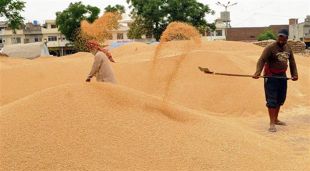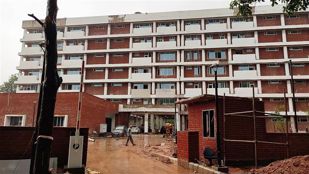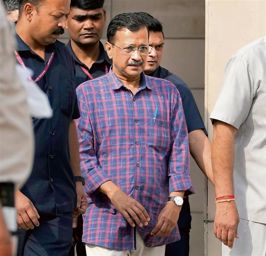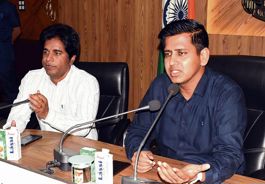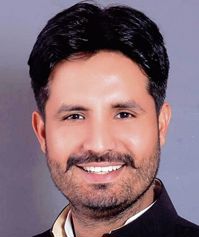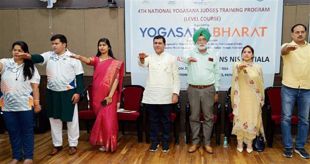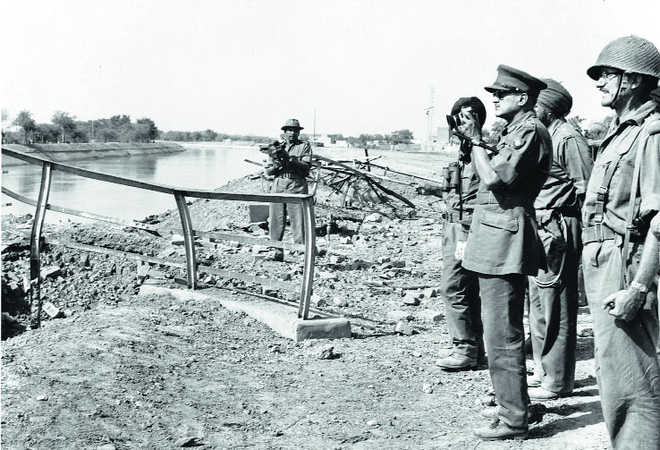
Gen JN Chaudhuri at Ichhogil canal on September 23 after the ceasefire
Manohar Singh Gill
I joined the Punjab cadre of IAS in 1958. In August of 1965, with seven years of service behind me, I was appointed the Deputy Commissioner of Ambala, the old British district which stretched from the Sutlej at Bhakra to the Yamuna on the border of Uttar Pradesh. There was no Haryana in 1965. Pakistan had already initiated trouble in Kashmir by sending across heavily-armed raiders. They were discovered and held. Soon, Pakistan launched a full-scale military push in Chhamb-Jaurian in an effort to capture the Akhnoor bridge across the Chenab, and cut off all links with Jammu and Kashmir. The situation rapidly escalated. Our Army began to mobilise and move to the Punjab border.
In the first days of September, I came home after a day-long tour of the Ropar area at 9 pm. My wife indicated that the area commander, Major General Bhatia, had been frantically searching for me. I had a quick bite and drove to the cantonment in the blackout darkness. I took the Superintendent of Police, Mr Birbal Nath, with me. Gen Bhatia made an amazing demand. He wanted me to move the Sixth Mountain Division from Lalru, on the Chandigarh road, to somewhere on the border immediately. The border, he said, was open. He demanded that the first battalion should leave by 2 am. Instinctively, I applied the mode of what the British called the ‘Punjab School of Administration’ — act first and find the authority and rules later.
I asked Mr Birbal Nath to set up barriers on the GT Road, commandeer every passing truck, unload the fruits, sugar, whatever, and form a convoy of 200 trucks. Mr Nath happily concurred with my decision. At 1 am, I took the convoy to get the fuel from the Army depot. To my horror, I found that the depot lay across the main lines, going from Delhi to Amritsar and beyond. The gates were shut and the Army-loaded wagons were whizzing past. We managed to get across, but were blocked by the soldiers at the depot, who refused to wake up their Major Sahib. I shouted him awake and they started to give diesel, which to my horror was in Second World War jerry cans. How could you pour those into trucks in the darkness? Somehow, we sent the first 200 trucks to Lalru.
I came home and rang up all my neighbouring Deputy Commissioners, waking them up and demanding that they pick up every bus/truck in the town, and send them to Ambala. Most of them were my seniors, but no one questioned my authority.
The next day, I made a simple authority slip, which was given to every truck driver, to be produced after the war. I took over all the petrol pumps along the GT Road, and started filling the trucks with diesel on my authority, quickly and smoothly. Trucks continued to pour in from the neighbouring districts till we lifted the Division to the front. When we had no more trucks, I rang up Delhi. It was not their war. They demanded that I pay for the fuel! I sanctioned it. The Delhi officers showed little interest in Punjab’s travails.
All this while, I did not care to consult the Punjab government, as post Kairon, it could not be accused of any decision-making capacity. I did all this confident in the belief that my actions were in the national interest, and would be upheld. What amazed me was that the Sixth Mountain Division had been brought from beyond Bareilly in civil transport. The Army dumped it in Lalru, without any thought on how it would go to the border. No planning and no warning to the civil authority. Today, when I travel to Chandigarh as I enter Ambala, I look across the railway lines to the fuel depot, which has still not been moved to a correct location in the main cantonment.
We were bombed twice, since Ambala is the biggest airbase in the area. The DC’s house is at one end of the runway, and the cantonment with its hospital is at the other. Two ancient Canberras flew over my ‘house’. We could see the shadow pass over. As it turned out, they dropped a few bombs over Model Town, smashing houses, and a few at the other end on the Military Hospital. The pilots were new to war. Our people were seeing the war for the first time. There was hysteria in Model Town. We calmed them.
The next day, I went to the Military Hospital; some patients had died. The Bishop had come down from Delhi, and he came to see me. He said he would pray for us. I asked where he was staying. He said in the cathedral compound. As it happened, the bombers came again that night. This time they dropped two bombs right through the roof of the cathedral, built in 1865, and blew it apart. The Bishop had spent the night in a trench and survived.
I realised the value of propaganda. The Government of India was not letting any journalist come to Punjab. I begged and got a team of Indian and international press. I painted to them the horror of the hospital bombing, and the church destruction. I reminded them of the Coventry Cathedral, destroyed by the Germans. We got a good story across the world. As it happened, the Pakistan Air Force missed a great chance. Our fighter planes used to operate during the day from Punjab’s forward airfields. At night, they were all parked at Ambala. If those silly boys had dropped only one bomb on the runway, we would have lost all our frontline fighters.
We managed complete surprise when we attacked across the Punjab international border, with three Divisions, but showed no boldness and planning. We got stuck at the Ichhogil Canal, just across the border, and generally milled around in the first few miles. The General on the Lahore front ‘withdrew’ from his jeep, leaving his maps and plans behind! He was replaced, but this being India he was again given command elsewhere later. The Tank Division was taken beyond Pathankot and massed with two more Divisions opposite Sialkot. The countryside was open, with no canal obstacles, ideal for tank warfare. We had the surprise advantage. But again we milled around, in the first 7 to 10 miles, and failed to take Sialkot.
The Pakistan army relocated their artillery and tank units and effectively blocked us. The Pakistan Tank Division attacked from Kasur towards Tarn Taran. Their ineptitude led to delays in crossing the Kasur Nullah, and they got stuck in September crops and soggy soil, as the water distributaries had been cut. They were bold but incompetent.
It is true that Army Chief Gen Chaudhari panicked at the Pakistan armoured division attack and wanted Gen Harbaksh Singh to pull back to the Beas river, leaving Amritsar and half of Punjab to the enemy. We were lucky in 1965 that Gen Harbaksh, the Army Commander, Gen Dhillon, the Corps Commander, and Gen Gurbaksh Singh, the 4 Division Commander, were all Sikhs, fighting for their home and hearth.
Gen Harbaksh refused to withdraw, and saved the day. We ended on their side rather than back on the Beas. Sadly, Gen Harbaksh Singh, like Gen Aurora after Bangladesh, never got his due.
The people in Punjab backed the Army right up to the frontline, even feeding it. Thousands of truck drivers carried ammunition to the frontline, many losing their lives. Sadly, in our distorted conferment of honours, not one truck driver was recognised. Even in the Army, something surprised me. Most Major Generals from Kashmir to the Rajasthan Thar Desert were given a Maha Vir Chakra!
In armies in the West, such medals are given only to soldiers and young officers who fight and die in the face of the enemy. Generals never do that. They sit safe, far back, plan and launch attacks. This practice, I think, continues with the Generals happily awarding each other even now. I’m sure the same practice prevails in Pakistan.
(The writer is a Rajya Sabha MP)





















